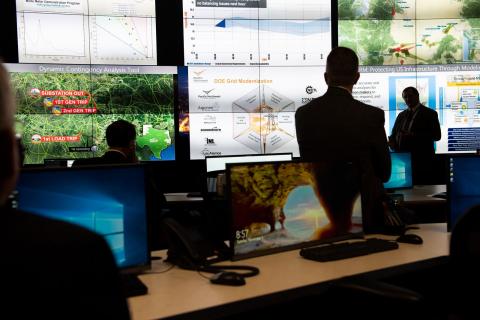Collaborations

Synchrophasor Training
DOE’s Office of Electricity sponsors work to advance the adoption, through training, of novel synchrophasor applications in the real-time grid operations environment. This training project uses a fully functional energy management system in the EIOC to train operators and dispatchers in to build out simulated use cases on advanced applications. The project also explores opportunities for using machine learning and artificial intelligence in real-time operations and also looks at human elements and human-machine teaming for more efficient and effective real-time operations.
Cybersecurity Situational Awareness for Operational Technology
The Cybersecurity for Energy Delivery Systems program out of DOE’s Cybersecurity, Energy Security, and Emergency Response program sponsored a project in the EIOC to build out an operational technology (OT) cybersecurity visualization dashboard to help control room operators and cybersecurity analysts access critical OT network information during a cyber-attack. The dashboard creates a unique tool that bridges the operator/cybersecurity communication gap when managing cybersecurity issues on an OT network. The tool was wholly designed, developed, and tested in the EIOC control room and OT network environment to address challenges with joint, real-time communications between operations and OT cyber. The tool also provides visualization design, including cognitive systems engineering, human factors, and user experience.
Big Data Analytics, Machine Learning, and Artificial Intelligence
The EIOC’s dedicated network and server farm have been instrumental in enabling PNNL to support the DOE Office of Electricity’s Funding Opportunity Announcement #1861 for big data analytics, machine learning, and artificial intelligence. The project used the EIOC to acquire, store, process, curate, and distribute large volumes of utility synchrophasor data from across the three primary U.S.-based transmission interconnects for use by the award recipients in their machine learning and artificial intelligence research projects.
Universal Utility Data Exchange
The Cybersecurity for Energy Delivery Systems program out of Cybersecurity, Energy Security, and Emergency Response Office has sponsored a project to improve information exchange between control centers in the energy industry. In order to demonstrate the results of the research, a prototype Universal Utility Data Exchange (UUDEX) implementation was established in the EIOC, with connections to similar implementations at our partner sites in the Midwest and on the East Coast using the public internet to connect them. The UUDEX project team was able to use the dedicated EIOC internet access point, thereby minimizing the approvals needed to securely establish machine-to-machine links between the PNNL-resident UUDEX server and those resident at our partner sites.
Washington State University and National Science Foundation
Washington State University (WSU) has partnered with PNNL and other industry partners as a part of a National Science Foundation research project titled “Enabling Power Grid Resiliency: Tools for Operators and Cognitive Analysis.” The goal of the project is to develop new machine learning-based approaches to provide decision support tools for control room operators that enhance situational awareness and enable better decision-making by achieving a balance between human actions and automated tools through cognitive analysis. In addition to providing subject matter expertise on relevant use cases for testing operator situational awareness and on the configuration of their test environment, PNNL is helping the WSU team federate their smart grid laboratory with the EIOC to leverage some of its unique capabilities.
The planned federation will enable the EIOC to serve as a remote network and security operations center for a simulated utility control center, which will be implemented within WSU’s laboratory. This scenario closely mimics the architecture that several utilities have in the real-world, where the cybersecurity analysts are geographically dispersed apart from the control center operators. This involves the interconnection of EIOC with WSU over a virtual private networking tunnel to enable the forwarding of cybersecurity logs from WSU’s smart grid laboratory to a secure information and event management platform (Splunk) running inside the EIOC to perform cybersecurity log aggregation and analytics.
GridAPPS-D
DOE’s Office of Electricity, Advanced Grid Research sponsors the GridAPPS-D™ project, which is focused on reducing the time and cost to integrate advanced functionality into distribution operations to create a decarbonized and more resilient grid. The GridAPPS-D project utilized the EIOC to provide a realistic operational environment to test and evaluate a set of advanced distribution focused applications developed on the GridAPPS-D reference architecture. The EIOC was used to train distribution operators on the advanced applications and support a realistic two-day storm simulation on the GridAPPS-D platform. The realistic environment allowed distribution operators and engineers to provide detailed and focused feedback from an operational perspective.